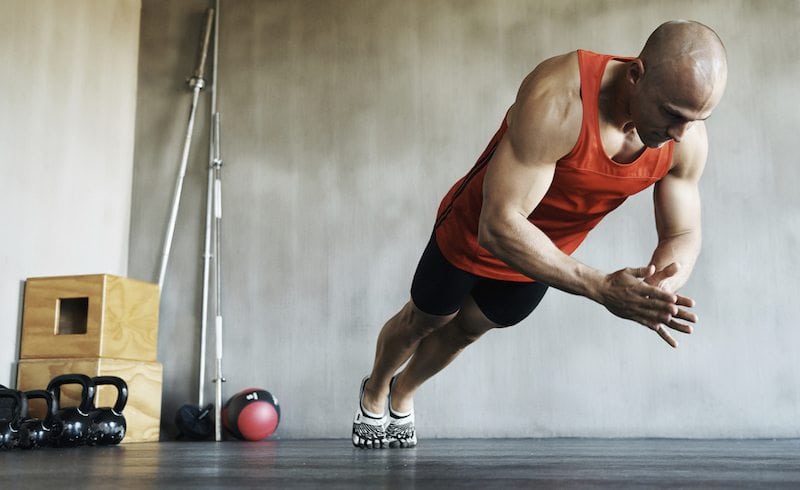No products in the cart.
Plyometrics for Muscle Growth

Plyometrics training has been around for decades, but has become very popular in recent years.
Companies such as Crossfit have shined a light on the benefits of plyometrics, and even amateur sports clubs have started using it.
There are many benefits of Plyometrics which we will look into, but is there a positive effect on muscle growth?
What is Plyometrics?
Plyometrics is a form of training that involves explosive movements, particularly jumps, hops, or bounding.
Box jumps are one of the most well-known plyometric exercises but there are also jump squats, plyometric press ups, and depth jumps.
The Known Benefits of Plyometrics
Plyometrics plays a huge role in the reduction in the risk of injury from gym-based exercises but particularly sporting based ones.
A study by Chimera et al (2004) found that plyometrics could help prevent injury improving joint stability [1].
Lowering injury risk is vital for both gym-goers who are looking to build muscle, and sportsmen and women looking to perform to their highest level without injury.
Speaking of sporting performance, plyometrics can improve many of the different aspects of different sports. It can improve running economy [2], which is essential in conserving energy which leads to improved performance as the athlete has less fatigue.
Plyometrics have also been shown to improve agility [3], acceleration [4], and sport specific movements such as a golf drive [5]. This last one is probably the result of plyometrics effects on both strength and more importantly power.
A study by McCormick et al in 2016 found that plyometrics improved change-of-direction speed and power in female basketball players [6].
Another study in 1999 found that plyometrics improved power output which the authors attributed to the significant increase in muscle fibre size [7].
Blakeyl & Southard (1987) looked into whether a combination of weight training and plyometrics could improve both strength and power [8] which it absolutely did.
This was also found in a 1992 study by Adams et al, here they discovered that a combination of squats and plyometrics was required to get the best power output (they used vertical jump height to measure power) [9].
A study in May 2015 found that plyometrics could significantly improve muscular strength which could then improve power. The plyometrics group was compared to a control group who only performed regularly sport rather than any strength training [10].
Does Plyometrics Increase Muscle Growth?
When you look at the studies mentioned above, a few of them say that the increases in strength and power are the result of increased muscle fibre size
Increased muscle fibre size is known as muscle hypertrophy and it is responsible for bigger muscles, so technically plyometrics has been shown to be responsible for muscle growth.
A better question is whether plyometrics is the best option for muscle growth? A study by Vissing et al (2008) found that Type I and Type IIa muscle fibres increased in size after a 12 week conventional resistance training program, but that there was no change in size after 12 weeks of plyometric training [11].
Clearly plyometrics has many benefits but if you’re looking for increased hypertrophy then it is almost certainly not for you. It would make more sense to stick to a traditional hypertrophy training program.
For example a full-body program that utilised higher reps, drop-sets, and eccentric training. You could possibly add some plyometrics training into this program but it would not benefit muscle hypertrophy.
Plyometrics seems to be most effective when it is being used to improve sporting performance, or to improve explosive strength and power.
If you were thinking about getting into Olympic lifting or power lifting then plyometrics would be a fantastic addition.
Plyometrics will lead to muscle growth, there’s no denying that! But it is not optimal just a nice little extra benefit. Too many people overcomplicate training, they want to find the perfect training program and fill it with every different program they can.
One week they’re doing German Volume Training whilst the next they are following plyometrics, then they’re super-setting exercises, and it’s circuits after that.
Establish what your goal for training is, are you planning on concentrating on performance (sport) or aesthetics.
If you train for sport then you may improve your physique too but it will be a side-effect. If you decide to train for aesthetic reasons you may also improve your sporting performance, but again this will just be an added benefit.
Improving sporting performance is an excellent idea, and too few people do so. People who play sports rarely train in the gyms as well, whilst people who train in gyms would get a lot of benefits from adding sport to their training.
Plyometrics would fit in well alongside most sporting programs, particularly sports that involve powerful movements such as rugby or shot put.
Save
Save
Save
